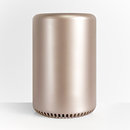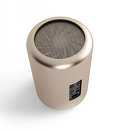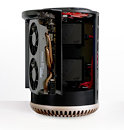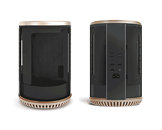Tuesday, March 8th 2016
Dune Case is the Mac Pro Lookalike That Everyone Can Have
Dune Case is a premium small form-factor PC case that should instantly remind you of the latest Apple Mac Pro, but packing whatever hardware (or software) you wish it had, in its 260 mm x 215 mm x 215 mm dimensions. Its designer is raising $130,000 on Kickstarter to get it to the shelves, and has already raised half the amount, with 8 days of fundraising to go. You can back the project from this page. The aluminium-built case comes in rose gold and black.
Unlike the Mac Pro, which features a cylindrical design with key components arranged along three sides of a triangular structure, with cooling machinery taking up its center; the Dune Case takes a different approach. It's spit into three compartments vertically along the bore of the cylinder, with the center holding a mini-ITX motherboard, one side with room for a full-height yet under 185 mm graphics card (connected to the motherboard through a PCIe riser); and the third compartment holding two 2.5-inch drives. A custom rear panel plugs into your motherboard, and an SFX power supply (not included) fuels your build. The main air channel is a 140 mm spinner that spouts warm air from the top.
Unlike the Mac Pro, which features a cylindrical design with key components arranged along three sides of a triangular structure, with cooling machinery taking up its center; the Dune Case takes a different approach. It's spit into three compartments vertically along the bore of the cylinder, with the center holding a mini-ITX motherboard, one side with room for a full-height yet under 185 mm graphics card (connected to the motherboard through a PCIe riser); and the third compartment holding two 2.5-inch drives. A custom rear panel plugs into your motherboard, and an SFX power supply (not included) fuels your build. The main air channel is a 140 mm spinner that spouts warm air from the top.




68 Comments on Dune Case is the Mac Pro Lookalike That Everyone Can Have
Modern chips do throttling more elegantly and gradually than older chips that just take a massive hit in performance (by dropping to the lowest multiplier or inserting idle cycles).80 C is fine. 84-85 C is also fine. But I'd personally prefer to have my video cards and processors not be in the 90s range. Besides being a high temperature there's not much headroom before they'll start reducing clocks.
Think about what Intel has to do to sell a chip that runs "up to 3.8 GHz". They have to make sure that chip is rock solid at 3.8 GHz at stock voltage. Otherwise people are going to hit problems when the chip turbos to that speed, much like what happens if you overclock too far. I get that throttling has a bad connotation and that Intel/AMD/Nvidia would prefer to avoid it. But in the end, if the chip clocks down due to thermal constraints, you've paid for a chip binned to hit 3.8 GHz but not getting that speed.
To reiterate my previous point and clarify, the manufacturer could pick a crazy high stock voltage for turbo (AMD does that sometimes) so more chips fit into the "can stay stable at 3.8 GHz" bin. That doesn't matter at all. I still don't want to pay for a chip that is binned to run at 3.8 GHz and not get that speed due to thermal constraints.
To clarify further, take the silicon lottery site for example. If you paid for a chip they tested to run at 4.5 GHz, and then ended up running it at 3.5 GHz because of thermal constraints, is that a good use of the extra money?
I prefer a system in which the chip in question doesn't downclock due to thermal constraints. Is that fair?
As for the vid I don't think you realize how high the 9370/9590 go...
The VID used has absolutely zero relevance to the discussion. Can we agree on that? I don't care if AMD shoves 3 V through the CPU to make it stable at that speed, as long as it lasts. What matters is that the processor is binned to be stable at that frequency, and be stable there for a really long time even under max load. If it's not, it should be RMA-ed. And if Intel/AMD/Nvidia put out a chip that became unstable at boost frequencies after being pushed there for sustained workloads, there'd be a ton of RMAs.
But yes, I get your point - Intel, AMD, and Nvidia do not guarantee turbo/boost clocks will be sustained (so those chips can be used by OEMs in designs unable to cool them if the chip was continuously run at the speed it was binned to be stable at). My personal gripe is just with paying for a chip guaranteed to reach a certain frequency, and then not using it there. I understand you guys are fine with that. I guess we should agree to disagree here.
Turbo works like this: Intel tests a processor and it passes for running at 3.8 GHz. However, it pulls 56 W when fully loaded at that speed. OEMs say "our designs can't cool a 56 W chip. we can deal with 47 W though." Intel responds by saying "no problem, we'll put a 2.8 GHz sticker on it because we know it won't draw over 47 W at that speed. We'll still let it hit 3.8 GHz under load and it will draw 56 W when it does so a higher 'boost' clock can be advertised and bursty workloads benefit, but if the workload is sustained it'll just hit 99 C, reduce clocks to keep itself from going past that, and probably sustain somewhere near 2.8 GHz provided your cooler deals with 47 W. That's fine because we never guaranteed 3.8 GHz."
That's what I observed from a HP laptop I owned. When using all four cores it consistently drew 55-57 W according to intel power gadget, until it hit 99 C and clocks started dropping. The chip was an i7-4900MQ.
Are we on the same page now? :)